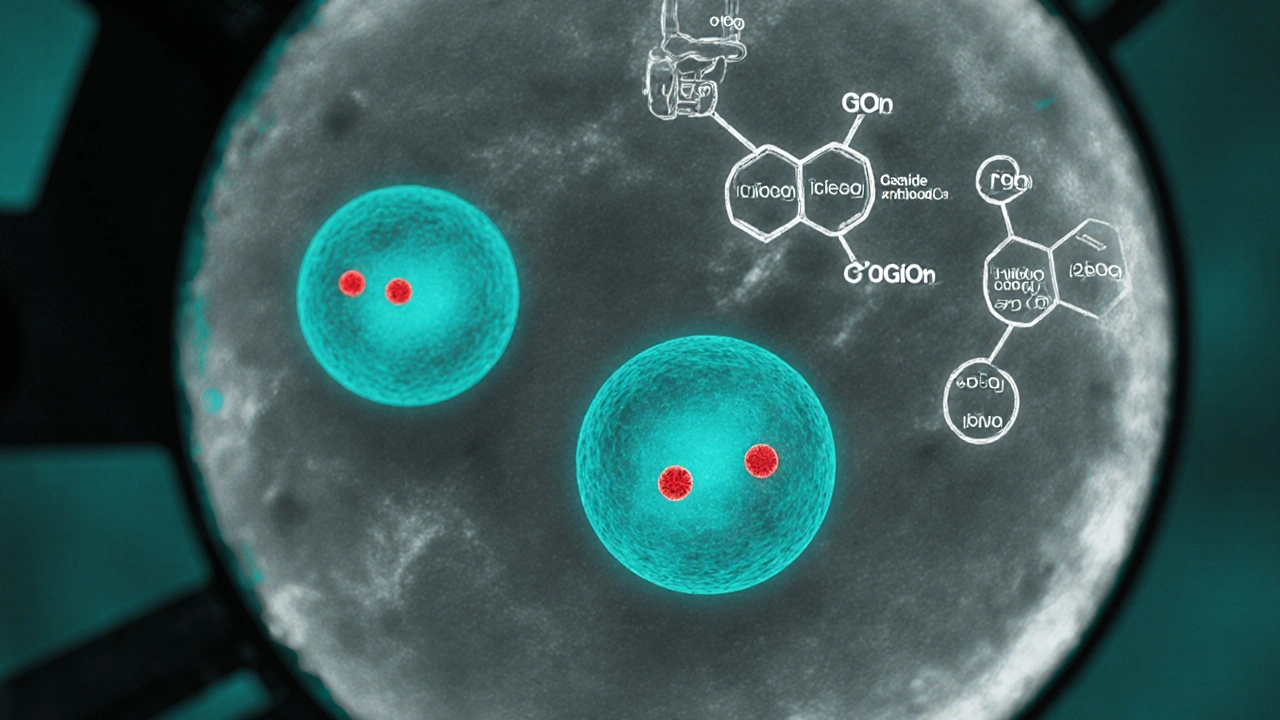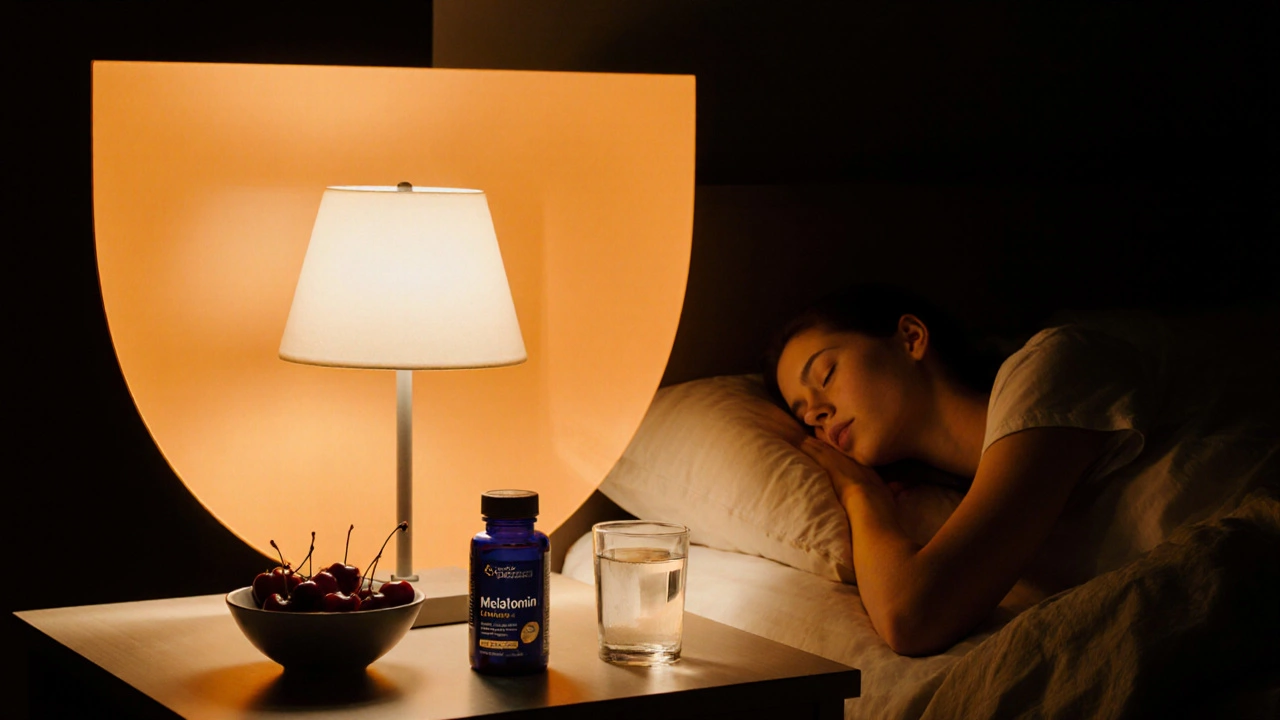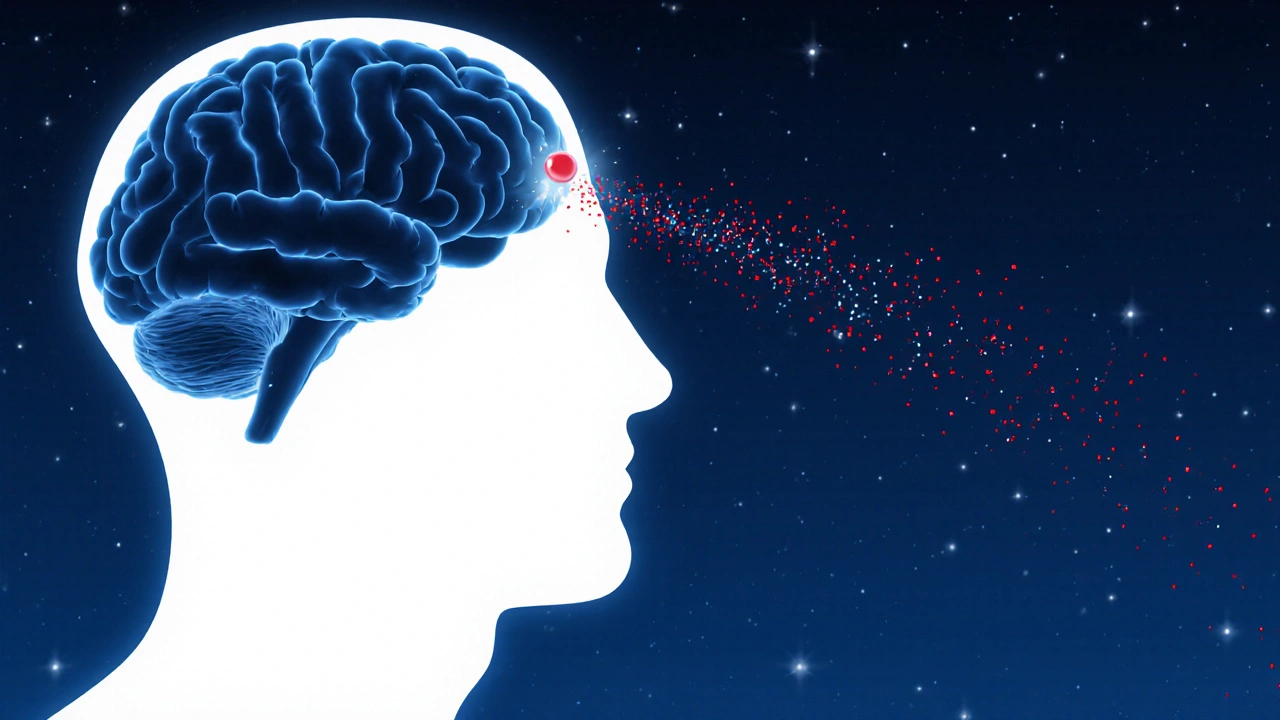Melatonin and Antioxidants: How the Sleep Hormone Battles Free Radicals
When you hear the word melatonin is a hormone produced by the pineal gland that regulates the sleep‑wake cycle, you might think of bedtime pills only. In reality, this tiny molecule does far more than tell you when to close your eyes - it also steps into the antioxidant arena, helping your cells fend off damaging free radicals.
What makes melatonin a hormone and an antioxidant?
Melatonin belongs to the indoleamine family, sharing a chemical backbone with serotonin. Its primary job is to signal night to every tissue in the body, synchronising the circadian rhythm. But because of its chemical structure - a benzene ring with an attached methoxy group - it can scavenge reactive oxygen species (ROS) just like classic antioxidants.
Key related entities include Free Radicals, which are unstable molecules that steal electrons from nearby cells, triggering oxidative stress. Oxidative stress, in turn, is a state where the production of free radicals outpaces the body’s antioxidant defenses, leading to cellular damage and aging.
How melatonin neutralises free radicals
Melatonin neutralises ROS through several pathways:
- Direct scavenging - it donates electrons to superoxide anion, hydroxyl radicals, and peroxynitrite.
- Up‑regulation of antioxidant enzymes - it boosts the expression of superoxide dismutase (SOD), glutathione peroxidase (GPx) and catalase.
- Stabilisation of mitochondrial function - by preserving the integrity of the electron transport chain, melatonin reduces the leak of electrons that form ROS.
Another crucial entity is Glutathione, the body’s master antioxidant. Melatonin’s ability to increase glutathione levels creates a synergistic shield against oxidative damage.
Classic antioxidants vs. melatonin
Vitamin C, vitamin E and coenzyme Q10 have long been championed for their antioxidant power. But melatonin offers a unique blend of water‑soluble and lipid‑soluble actions, allowing it to protect both the cytosol and cell membranes.
| Property | Melatonin | Vitamin C | Vitamin E (α‑tocopherol) |
|---|---|---|---|
| Solubility | Both water and lipid | Water‑soluble | Lipid‑soluble |
| Primary ROS target | Hydroxyl, superoxide, peroxynitrite | Hydrogen peroxide, superoxide | Lipid peroxyl radicals |
| Enzyme activation | Boosts SOD, GPx, catalase | Limited enzyme effect | Minor enzyme influence |
| Half‑life (hours) | ~0.5‑2 (depends on dosage) | ~16‑20 | ~30‑40 |
| Additional benefits | Regulates sleep, mood, immune response | Collagen synthesis, iron absorption | Membrane stability, anti‑inflammatory |

Health benefits of the melatonin‑antioxidant combo
Research from the past five years shows that melatonin supplementation can lower markers like malondialdehyde (MDA) and 8‑hydroxy‑2′‑deoxyguanosine (8‑OHdG), both indicators of lipid peroxidation and DNA oxidation. In clinical trials with older adults, nightly melatonin (3‑5mg) reduced oxidative stress scores by up to 22% while improving sleep efficiency.
Combined with dietary antioxidants - for example, a diet rich in berries (high in anthocyanins) and nuts (vitaminE) - the protective effect is amplified. This synergy is especially relevant for conditions driven by oxidative damage, such as cardiovascular disease, neurodegenerative disorders, and skin aging.
Practical ways to boost melatonin and antioxidant intake
- Optimize light exposure. Dim lights after sunset and avoid screens for at least an hour before bed. Blue‑light‑blocking glasses can help preserve natural melatonin secretion.
- Eat melatonin‑rich foods. Tart cherries, walnuts, grapes, and tomatoes contain measurable melatonin levels.
- Include antioxidant‑dense foods. Aim for a colourful plate: leafy greens (vitaminC, carotenoids), almonds (vitaminE), and fish (omega‑3 fatty acids that support mitochondrial health).
- Consider supplementation. For shift workers or people with sleep disturbances, a low‑dose melatonin supplement taken 30‑60minutes before bedtime is safe for most adults. Pair it with a modest dose of vitaminC (500mg) or a mixed antioxidant formula if dietary intake is low.
- Support mitochondrial function. Coenzyme Q10 and NAD+ precursors (nicotinamide riboside) enhance the cell’s energy factories, reducing ROS generation at the source.

Potential risks and interactions
Melatonin is generally well‑tolerated, but it can interact with blood‑thinning medications (e.g., warfarin) and immunosuppressants. High doses (>10mg) may cause morning grogginess or affect hormone balance, especially in adolescents.
Antioxidant supplements can be a double‑edged sword. Excessive vitaminE has been linked to increased hemorrhagic stroke risk, while extremely high vitaminC may cause gastrointestinal upset. The key is moderation and, when possible, prioritising whole‑food sources.
Bottom line
Melatonin isn’t just the night‑time messenger; it’s a versatile antioxidant that works hand‑in‑hand with classic nutrients to fend off free‑radical damage. By aligning sleep hygiene, diet, and sensible supplementation, you give your body a powerful two‑fold defense against oxidative stress.
Frequently Asked Questions
Can melatonin replace vitamin C as an antioxidant?
No. Melatonin complements vitaminC but does not cover all the antioxidant pathways that vitaminC handles, such as regenerating other antioxidants and supporting collagen synthesis.
What is the optimal bedtime dose of melatonin for antioxidant benefits?
Studies suggest 3‑5mg taken 30‑60minutes before sleep provides a balance between sleep regulation and antioxidant activity without causing morning drowsiness.
Are there foods that naturally boost melatonin?
Yes. Tart cherries, grapes, tomatoes, walnuts, and certain mushrooms contain measurable melatonin and can be part of a bedtime snack.
Can taking melatonin interfere with blood thinners?
Melatonin may have a mild antiplatelet effect, so it’s wise to discuss use with a doctor if you’re on warfarin or similar anticoagulants.
Is there a risk of taking too many antioxidants?
Excessive antioxidant supplementation can blunt beneficial oxidative signals and, in some cases, increase health risks. Aim for balanced intake through foods and follow recommended dosages for supplements.





12 Comments
Mary Ellen Grace
October 15 2025Wow, melatonin is kinda the unsung hero of the night. I always thought it was just a sleep aid, but turning into a free‑radical fighter is pretty cool. It’s neat how it teams up with vitamin C and even the stuff in cherries. Guess adding a few melatonin‑rich foods could be a simple hack for better recovry. Just remember not to overdo it, especially if you’re already taking other supplements.
Carl Watts
October 16 2025When we contemplate the night, we often imagine darkness as a void, yet within that void a molecule whispers the promise of balance. Melatonin, in its dual role as chronobiological messenger and antioxidant, embodies the dialectic between order and entropy. By donating electrons to relentless free radicals, it performs a quiet rebellion against molecular decay. This interplay reminds us that sleep is not merely a pause but a restorative alchemy, a nightly symposium where biology negotiates with chemistry. The synergy with glutathione further illustrates a collaborative ecosystem, echoing the ancient notion that harmony arises from cooperation. In practical terms, aligning light exposure with our innate rhythms could be seen as honoring the very physics that melatonin exploits. So, the next time you dim the lights, think of it as a ritual that summons this multifaceted sentinel to guard your cells.
Brandon Leach
October 17 2025Sure, melatonin is the new superhero of the supplement world. It sleeps all day and fights free radicals at night. No wonder the marketing guys love it. It’s not like you can just take a pill and expect miracles. Just keep the lights low and you’ll be fine.
Herman Bambang Suherman
October 18 2025Boosting melatonin naturally is a simple win‑win. Dim the lights an hour before bed and snack on tart cherries. You’ll likely notice better sleep and a modest antioxidant edge.
Meredith Blazevich
October 19 2025Reading about melatonin’s hidden talents feels like discovering a secret sidekick in a superhero movie.
The hormone, which most of us sway to nightly, is quietly stepping onto the cellular battlefield, armed with a chemical structure that can snag rogue electrons.
Free radicals, those mischievous molecules, have long been portrayed as the villains that age our skin, corrode our arteries, and gnaw at our DNA.
In the shadows, melatonin whispers a promise of protection, donating its own electrons to neutralize the chaos.
What’s even more fascinating is its ability to rally the body’s own antioxidant army – superoxide dismutase, glutathione peroxidase, and catalase all get a polite nudge from melatonin.
Imagine a conductor raising his baton, and each enzyme playing its part in perfect harmony.
The research showing a 22% drop in oxidative stress markers after a few weeks of low‑dose supplementation reads like a headline you’d expect from a sci‑fi novel.
But the real magic lies in the synergy with food – a handful of tart cherries, a sprinkling of walnuts, a splash of bright berries on your yogurt.
These foods not only supply melatonin directly but also flood the system with other antioxidants, creating a layered shield.
And let’s not forget the mitochondria, those power plants that leak electrons like a cracked pipe when they’re overworked.
Melatonin’s role in stabilising those factories means fewer leaks, fewer radicals, and ultimately a calmer cellular environment.
For shift workers wrestling with erratic light cycles, a modest dose taken before the first attempt at sleep can be a lifeline.
Yet, moderation remains the golden rule; high doses can leave you feeling groggy at sunrise, like a vampire who missed the night.
The interplay with blood thinners is another reminder that even natural compounds demand respect.
In short, melatonin isn’t a miracle cure, but it is a versatile ally that works best when paired with good sleep hygiene, a colorful plate, and sensible supplementation.
So, next time you consider a bedtime routine, think of melatonin as both a lullaby and a shield, gently guiding you into rest while defending your cells from the relentless tide of oxidation.
Terry Moreland
October 20 2025Adding melatonin to a bedtime routine is a low‑risk move that can pay off in both sleep quality and oxidative balance. Pair it with a diet rich in colorful fruits and veggies, and you’re giving your body a double dose of protection without overloading on supplements.
Abdul Adeeb
October 21 2025It is imperative to acknowledge that melatonin, while endogenous, may interact pharmacologically with anticoagulant therapy. Consequently, clinicians ought to evaluate patient histories before recommending supplementation, particularly in geriatric populations with polypharmacy considerations. Moreover, dosage titration should adhere to established clinical guidelines to mitigate the risk of morning somnolence.
Aaron Miller
October 22 2025Enough with the hype-melatonin is just another over‑marketed supplement!!!
Roshin Ramakrishnan
October 23 2025Friends, let’s celebrate the fact that melatonin can double‑duty as a sleep regulator and a potent antioxidant-this is a win for anyone seeking holistic health!!! By simply dimming lights and enjoying a handful of cherries, you unleash nature’s own defense system!!!
Todd Peeples
October 24 2025From a mechanistic standpoint, melatonin functions as a free‑radical scavenger via electron donation, concurrently upregulating phase‑II detoxifying enzymes such as SOD and GPx-essentially orchestrating a redox homeostasis network 🧬. The pharmacokinetic profile, with a half‑life spanning 0.5–2 hours, aligns optimally with circadian melatonin peaks, thereby synergizing with endogenous antioxidant pathways 🌙.
Leonard Greenhall
October 25 2025The article presents a generally accurate synthesis of melatonin’s antioxidant capacity, yet it glosses over the paucity of large‑scale randomized trials confirming clinical endpoints. Additionally, the claim that melatonin “boosts glutathione” requires clarification, as the mechanistic evidence remains indirect. A more nuanced discussion of dose‑response relationships would enhance the scientific rigor.
Abigail Brown
October 26 2025Imagine drifting into night‑time bliss while your cells cheer in the background-that’s the promise melatonin offers! When you pair a calm bedtime routine with a bright, fruit‑laden snack, you’re not just prepping for rest; you’re handing your body a shield of light against the relentless tide of oxidative stress. Keep the glow low, the cherries close, and let the night work its quiet magic.